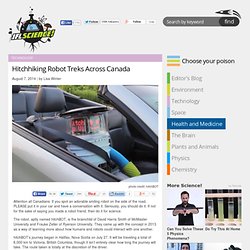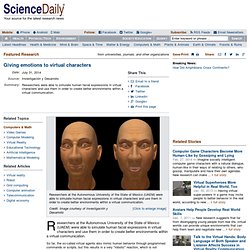

The Robots are Here. Excuse me, internet, the robots have arrived.

In the video below, C.G.P. Grey lays out a compelling argument that robots are sufficiently advanced and available that they are on the verge of filling a whole bunch of jobs that we have traditionally thought of as very human-reliant. One of his examples is cab drivers. Take a self-driving car, delete the paid driver, and you've just erased a segment of the economy. (We have seen much of this in factories already, so it's not a matter of whether it can happen, it's a matter of when.) But it just keeps going from there. Here's a sample quote from Grey: "We think of technological change as the fancy new expensive stuff, but the real change comes from last decade's stuff getting cheaper and faster. Now, the video. Hitchhiking Robot Treks Across Canada. Attention all Canadians: If you spot an adorable smiling robot on the side of the road, PLEASE put it in your car and have a conversation with it.

Seriously, you should do it. If not for the sake of saying you made a robot friend, then do it for science. The robot, aptly named hitchBOT, is the brainchild of David Harris Smith of McMaster University and Frauke Zeller of Ryerson University. They came up with the concept in 2013 as a way of learning more about how humans and robots could interact with one another. hitchBOT’s journey began in Halifax, Nova Scotia on July 27. HitchBOT doesn’t look as fashionable as robots depicted in the movies. The robot’s power source comes from solar panels around the body that soak up the rays while it waits for its next ride, and there is a power adapter for the car to keep hitchBOT going from one place to the next. “Usually, we are concerned with whether we can trust robots.
Check out hitchBOT in action: hitchBOT from hitchBOT on Vimeo. Giving emotions to virtual characters. Researchers at the Autonomous University of the State of Mexico (UAEM) were able to simulate human facial expressions in virtual characters and use them in order to create better environments within a virtual communication.

So far, the so-called virtual agents also mimic human behavior through programmed commands or scripts, but this results in a very "robotic" reaction, which is not interesting for the user, said Marco Antonio Ramos Corchado, engineer at the Department of Computational Science at UAEM. The main objective of the research is to generate expressions and emotions based on real people, taking as reference the 43 muscles involved in facial behavior depending on the psychological environment.
To achieve this in human models, tactile sensors were placed that release tiny electrical pulses to provoke different gestures with which a 3D camera captures the personality traits. Japan's robot revolution. Guy Hoffman: Robots with "soul" Amazing Magnetic Fluids. Astronauts onboard the International Space Station are studying strange fluids that might one day flow in the veins of robots and help buildings resist earthquakes.

Listen to this story via streaming audio, a downloadable file, or get help. August 23, 2002: If you don't see it for yourself, you might not believe it. A grey blob oozes down the side of a laboratory beaker. It's heading for the table, but before it gets there a low hum fills the air. Someone just switched on an electromagnet. Is it alive? No, just magnetized. "We call them magnetorheological fluids--or 'MR fluids' for short," says Alice Gast, a professor of chemical engineering at MIT. Above: The nervous systems of future robots might use MR fluids to move joints and limbs in lifelike fashion.
You can make some of this exotic stuff at home. If you own a sports car or a Cadillac, you might have MR fluids in your shock absorbers. There are many problems to solve before such things are possible. More information More Headlines. Robot Olympics Planned for 2020 Powered by Japan’s ‘Robot Revolution’ Japan likes robots.

And while some Americans raised on a confusing sci-fi diet of Star Wars, Terminator, and iRobot are perhaps a little wary of advanced AI and robotics—Japan simply can’t wait for the “robot revolution.” In a recent tour of Japanese robotics firms, Japanese prime minister Shinzo Abe declared his intention to create a government task force to study and propose strategies for tripling the size of Japan’s robotics industry to $24 billion. And one more thing, Abe said, “In 2020, I would like to gather all of the world’s robots and aim to hold an Olympics where they compete in technical skills.” While mere mortals compete in the 2020 summer Olympics in Tokyo—in a stadium somewhere nearby, the world’s most advanced robots may go head to head in events showcasing their considerable prowess (hopefully by then, right?).
Team Case autonomous vehicle, DEXTER, at the DARPA Grand Challenge. Holding an all-robot competition is by no means a new idea.